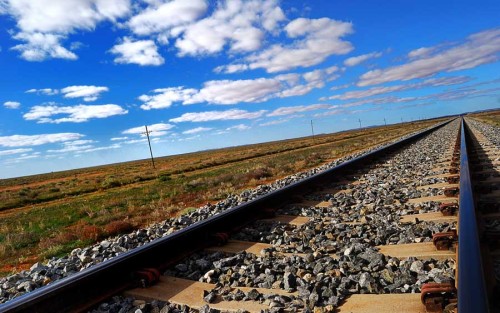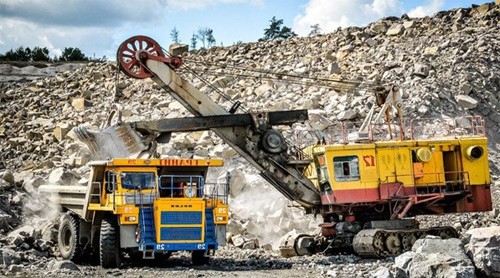
Crushed stone granite: scope of use Building materials

Granite crushed stone - bulk nonmetallic building material produced from rock. Depending on what exactly the development of a career occurred and how material was carried out, in the final result it has various characteristics. How exactly the classification of granite rubble and where different stamps are used, you will learn from this article.
Content
Granite crushed stone - composition
Granite in nature is a monolithic rock formed from the frozen magma. Components are present in its composition:
- spar;
- mica;
- quartz.
This causes the characteristics and properties of not only the stone itself, but also building forms from it.
Important! Due to the presence of various breeds at the base, concrete on granite rubble can have a shade with grinding green, gray, red, pink.
If a more diverse color palette is required, a combination of granite and limestone crushed stone is used. In this case, additional options appear - yellow, brown, white.
Types of granite rubble
Granite crushed stone varies in several criteria. The sphere and recommended applications are determined by the size of the fractions. The same indicator is the main parameter to determine the strength.
According to this principle, such types of granite rubble are distinguished:
- Opening. This is a secondary raw material that is obtained in the process of developing a career. The maximum size of the stones of this type is 5 mm. The grade of the strength of the explicit granite rubble - M 1000.
- Accompanying. One of the available and convenient types of granite rubble, whose fractions vary in the range of 5-20 mm. Depending on the amount of dust, the stated storage stamp corresponds to M 800-1200.
- Medium-complete. The most popular and frequently used type of this material, the dimensions of which are 20-40 mm. The dust content is a maximum of 0.35%, due to which the stroke of the strength corresponds to M 1000-1400.
- Enlarged. This type of granite rubble is usually available on sale with fractions from 40 to 60 mm. When the dust content of 0.25%, the strength grade is M 1000-1200. But the range of application of such a material is not wide.
- Large. The size of the fractions varies from 60 to 150 mm with a dust content of no more than 0.68% and the strength corresponding to the M1000-1600 brand.
Important! Each type of granite rubble to a greater or lesser extent finds its use in landscape design and construction. Which option is suitable for you, decide on the basis of the characteristics described below and the recommended appointment.
Characteristics of granite rubble
In addition to the strength and size of the granite rubble, there are a number of other characteristics to which it is also worth paying attention when choosing a material for specific purposes.
These include such properties:
- The degree of grain, determined by the homogeneity of the material. The structure of rubble affects the quality and density of shrinkage, adhesion to the binder mixtures, respectively - the strength of the construction form in the finished form.
- The shape of the elements, otherwise called testicle. Higher performance is achieved with the proper crushing of the rock for cuboid crushed stone. Stones with sharp corners or excessively flat are valued in terms of appropriate use of the application are much smaller, but also cost cheaper. The bulk density of good quality material corresponds to 1.4 t / m3.
- Frost resistance directly determines the possible life of a building structure under conditions of different temperatures. For granite rubble, the frost resistance mark corresponds to the high indicator in the F300-F400.
- Radioactivity affects the safety of the use of natural stone in the conditions of residential buildings and on soils, where useful and valuable cultures grow. The ecological purity of the granite rubble in this respect corresponds to all modern hygienic standards, and its resistance to the absorption of radiation is extremely low - 1 class of use.
Important! All parameters are governed by GOST 8267-93 standards.
The use of granite rubble
Granite crushed stone is used in various directions of landscape design and construction. It is most often used for the following purposes:
- building mounds when laying a roadway;
- ballasting railway tracks;
- design of concrete structures;
- bookmark the foundation;
- laying asphalt fabric, construction of garden tracks;
- registration of small architectural forms in the garden-park zone;
- the structure of bridges, airfields;
- the arrangement of temporary construction sites in the planned operation is hard special equipment;
- decorative design of artificial reservoirs and pools;
- construction of fences;
- use as the main filter material.
Mining and production of granite rubble
Granite crushed stone is made by developing quarries. Initially, the rock is exploded. For this, the brown is made of a deep hole in the rock. The hole is laid in the hole for undermining. As a result, a series of rock explosions is split into several blocks.
Further boulders and the resulting secondary raw materials are recycled. For this purpose, several ways are suitable:
- The use of crushing and sorting special equipment by means of which boulders are broken into pieces of the necessary fractions. Most often, rotary and centrifugal-shock systems are used for these works, and the cheek crushers are most used.
- Screening. When split the rocks, a stone is divided not only for large pieces, but also on fine particles. In order not to lose part of the useful material, perform sifting.
Important! At the end of the production work, the material is sorted to obtain the granite rubble of different types.

Conclusion
Granite crushed stone is not the cheapest bulk material, but its strength characteristics and the ability to choose the most suitable size quite justify the cost. Its use is the most appropriate for various construction work, as in this case the durability and reliability of structures are ensured.

























